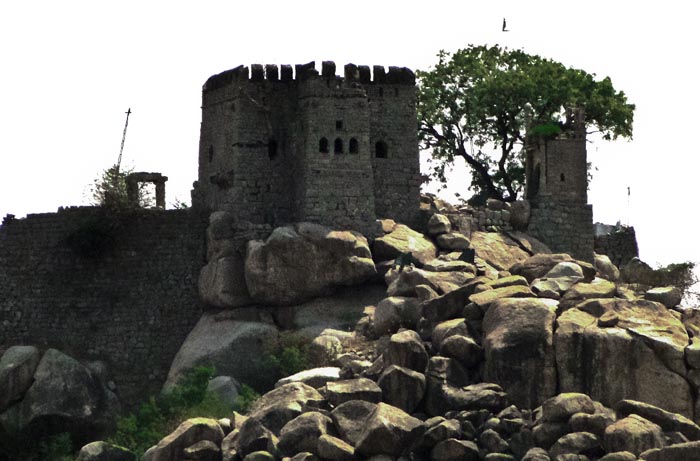Raichur Fort

Information on Raichur Fort (Raichur, Karnataka) - History & Architecture
Raichur Fort is one of the popular attractions of Raichur city of Karnataka. This fort was created by Kakatiya leaders in the year 1294 AD. Raichur Fort existed since the era of Chalukyas dynasty. Later during the era of Kalyana dynasty, the fort was refurbished. It stands as spectators of various rulers of Raichur region such as Mauryas, Rashtrakutas, Bahmanis and Nizams among others.
Raichur Fort Architecture
Raichur Fort is enclosed by dual rows of huge low circuit walls on three sides. It was constructed on 88 meter tall hillside. The inner wall of the fort is created by large stone made blocks which are joined together without any strengthening material. The outer wall of the fort is created by reasonably coarse stone masonry. Raichur Fort demonstrates the Muslim architecture, having captions written in Arabic and Persian languages in mainstays and entryways. These captions are supposed to belong to Ali Burj.
There are two entryways in inner walls of Raichur Fort in Hindu ramparts. The outer wall of the fort is bounded by deep earthwork on three sides, where the southern side is naturally protected by three stony hills, invigorated with huge ramparts. Inside the walls of Raichur Fort, there are various ancient structures and mosques of substantial archaeological interests. They contain captions honouring their creation through later Bahmani era. Several paintings are also curved on the walls of Raichur Fort.
The key architectural attraction of Raichur Fort is huge stone stab with a size of about 41 feet. The other attraction of the fort comprise five massive entryways in outer walls in Muslim ramparts. In the premises of Raichur Fort, there are number of reservoirs and remnants of ancient temples.
Raichur Fort History
It was believed that king Gore Gangayya Raddivaru ordered to create Raichur Fort in 1216 AD to king Vitthala. In 1284 CE, the fort was passed on to Vijaynagar Empire after the weakening of Kakatoya dynasty. Since then, the fort has been under clash for about two eras. According to some historians, the king of Vijaynagar created the northern entryway of the fort as a part of celebration for its takeover. In the year 1323 CE, Raichur Fort was captured by Bahmanis. However, Saluva Narasimha Raya, the king of Vijaynagar articulated the desire that Raichur Fort be recaptured again. Another king of Vijaynagar named Krishnadevaraya also has similar thought regarding the recapture of Raichur Fort. He even made extensive preparations in order to launch a grand assault on Raichur doab. The king requested every commandants in order to take active part in the battle.
In the year 1520 CE, the forces of king Krishnadevaraya become involved in the battle of Raichur. Afterwards, Raichur city capitulated to king Krishnadevaraya and he made a conquest entry into Raichur Fort. He was treated with sympathy and contemplation by Bahamins, but Krishnadevaraya was quite vicious towards Bahamani generals, because they has infringed human rights by killing several individuals who belong to Hindu society. Apart from Raichur Fort, another fort named Mughal Fort drew curiosity in Raichur area.
Raichur Fort Tourism Importance
Raichur Fort has observed significant battle over its conquest which makes it a place of historical significance. Furthermore, the fort also has various attractions such as huge stonework, entryways and inscriptions of them. The external and internal wall of the fort is also quite attractive and travellers can also enjoy the view of three rocky hills while visiting the fort.
- Bangalore Monuments
- Bagalkot Monuments
- Belgaum Monuments
- Bellary Monuments
- Bidar Monuments
- Bijapur Monuments
- Chitradurga Monuments
- Coorg Monuments
- Dakshina Kannada Monuments
- Gadag Monuments
- Gulbarga Monuments
- Hassan Monuments
- Mysore Monuments
- Raichur Monuments
- Uttara Kannada Monuments
- Yadgir Monuments
- Andaman Nicobar Monuments
- Andhra Pradesh Monuments
- Assam Monuments
- Bihar Monuments
- Chhattisgarh Monuments
- New Delhi Monuments
- Goa Monuments
- Gujarat Monuments
- Haryana Monuments
- Himachal Pradesh Monuments
- Jammu and Kashmir Monuments
- Karnataka Monuments
- Kerala Monuments
- Madhya Pradesh Monuments
- Maharashtra Monuments
- Odisha Monuments
- Punjab Monuments
- Rajasthan Monuments
- Tamil Nadu Monuments
- Telangana Monuments
- Uttar Pradesh Monuments
- West Bengal Monuments